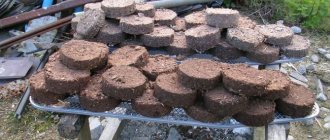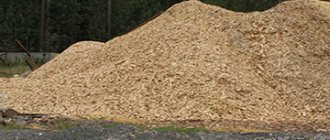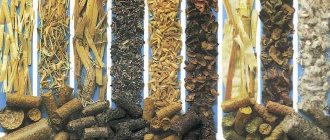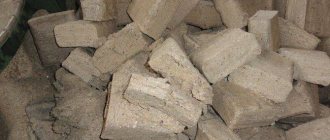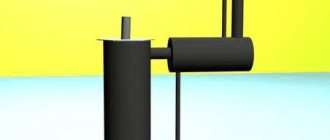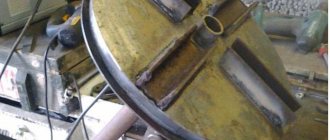It cannot be denied that sawdust briquettes are one of the most efficient types of solid fuel used for heating a home. They are high in calories (heat output is about 5 kW per 1 kg when burned), have a low ash content, and are also easy to store because they take up little space. But this fuel certainly cannot be called cheap; not everyone can afford to heat a boiler or stove with European wood throughout the entire season.
This is where many homeowners become interested - is it possible to somehow make fuel briquettes with your own hands? Especially when there are raw materials for this at a meager price. The solution to this issue is precisely the topic of this article. It will examine various technologies for producing briquettes from sawdust and other types of raw materials in production and at home. As a result, it will become clear under what circumstances it makes sense to take on this matter.
Methods for making briquettes
To get an idea of how you can make fuel briquettes with your own hands, you must first study how they are produced in a factory. The preparatory stage for any technology is the same and consists of grinding and drying the raw materials. These are, of course, sawdust and larger wood waste, which are processed to make briquettes. Then the raw material is dried in order to bring its moisture content to no more than 8-10%.
For reference. Also, various agro-industrial wastes (husks, seed husks) and even coal dust can serve as the starting material for the production of Euro-firewood.
Then the main operation begins - briquetting, in other words, sawdust pressing. Today this is done in two ways:
- Forming briquettes from sawdust on a hydraulic press.
- Production by extrusion method.
It must be said that with both technologies the result is achieved through strong compression of wood raw materials, as a result of which a natural component begins to be released from it - lignin. It serves as a binder for this crumbly mass; no other is provided. The only difference is in the compression method; in the first case, a hydraulic press for briquettes is used, developing a force of 300-600 Bar.
Due to such compression, the raw material spontaneously heats up, which only contributes to the formation of a strong rectangular “brick”. How a briquetting line with a hydraulic press functions is shown in the video:
This is how European firewood is squeezed out using a screw press
The extrusion method for producing briquettes from sawdust can be easily understood using the example of an ordinary home meat grinder or juicer. Raw materials are loaded into the receiving hopper of the unit and moved by a screw into a tapering conical working channel. There it is compressed, while the screw press for briquettes develops a monstrous force - up to 1000 Bar.
The output is firewood from sawdust in the form of a hexagon, which undergoes additional heat treatment and is cut to one size with a special knife. The sectional structure of a screw press for sawdust is shown in the drawing:
The main load falls on the auger (item 5) and the conical bushing (item 7), wear of the parts directly depends on the number of extruded briquettes
Basic elements of the press
The main elements of an ordinary press are a mold (a glass into which the bulk substance is placed), a piston and a pressure-creating mechanism. It is not difficult to make them yourself, as they are typical for briquetting machines.
Mold device
The glass into which sawdust or shavings are poured is called a mold or chamber. The parameters of the briquette will depend on its geometry.
Whatever the cross-sectional shape of the glass will be, this will be the type of briquette. But its length can be very different, but definitely not exceeding the height of the molds
Typically the chamber is constructed from scraps of round or shaped steel pipe. The base of the piston, which enters the glass, is cut out of a thick-walled (at least 3 mm thick) plate.
When making a mold, you need to take into account the ratio of the following quantities:
- cross-sectional area of the mold (s, cm2);
- applied pressure to the piston (u, kgf);
- specific pressure on raw materials (p, kgf/cm2).
These quantities are related by the relation:
p=u/s
Briquettes using an additional binder hold their shape well if they are formed at a specific pressure of more than 150 atm. (1 atm. ≈ 1 kgf/cm2). Based on the possibility of the force generated by the piston, the cross-sectional area of the chamber is calculated.
For example, if there is a 10 ton hydraulic jack, then:
s < u / p = 10000 / 150 = 67 cm2.
For such conditions, a profile square pipe with a side length of 80 mm or a round pipe with a nominal diameter of up to 90 mm is suitable.
The length of the resulting briquette (l) depends on the height of the mold (h), the density of the raw material in the initial dry (q1) and briquetted (q2) state:
l = h * (q1 / q2)
In addition, after the first compression, you can pour the chips into the glass again and repeat the procedure. In this way, you can bring the length of the resulting product almost to the height of the pressing chamber.
During the compression of sawdust, moisture is released from the briquette. In order for it to come out freely, the chamber is perforated with small but frequently spaced holes.
You can ensure the outflow of water from the chamber through holes that are made using a 2-3 mm metal drill
After the briquette is formed, it must be removed from the mold. Using a spring and a false bottom, as is often recommended on the Internet, is impractical. High pressure completely compresses the spring, so over time its shape becomes distorted, causing it to lose its properties.
Therefore, you need to either make a detachable bottom of the mold and push out the briquette, or build a collapsible cup. In the second case, you will need to make an additional shirt for him from a rod.
Available methods of creating pressure
There are three common ways to achieve pressure that are well suited for a homemade fuel briquette press: using a lever, a hydraulic jack or a screw. Each of them is good in its own way, and their implementation in practice is not very difficult.
Use of muscular strength and leverage
Usually a metal pipe is used as a lever. It should not bend under the influence of human muscular strength. For example, a reinforced water pipe with a diameter of 40 or 50 mm with a wall thickness of 4 - 4.5 mm is suitable.
Formula for calculating the piston pressure force (m) depending on the force applied by a person (M), the distance from the piston to the lever attachment point (l) and its total length (L)
The length of the lever and the distance from the fulcrum to the connection with the piston are chosen not only based on achieving the desired pressure. Another important parameter is the depth of immersion of the piston into the glass (h, cm).
It is calculated using the formula:
h = R * (l / L)
Here R (cm) is the height to which the end of the lever will fall.
It is advisable to make the structure in such a way that the depth of immersion of the piston is sufficient to form a briquette without repeated compression with preliminary addition of material. This will greatly increase the production rate.
The required immersion depth of the piston (h, cm) can be calculated knowing the initial dry (q1) and briquetted (q2) density of the raw material and the height of the glass (H):
h = H * (1 – q1 / q2)
If for some reason an error occurs (usually due to incorrect determination of the initial density of the raw material) and the depth of immersion of the piston is not enough to impart the required hardness to the product, then it is not necessary to digest the entire structure.
You can either reduce the height of the glass, or, adding sawdust, press one briquette in two or three passes.
Application of hydraulic jack
To create strong pressure, hydraulic devices are used, such as the usual bottle jacks. As a rule, in a household where there is a car or other equipment, such hydraulic units are available, but their carrying capacity may be insufficient.
The design of a typical hydraulic press consists of a frame and a movable beam on which a jack is placed. The system returns to its original position due to the action of springs
Jacks are inexpensive. Thus, models designed for 30-40 tons can be purchased for less than 5 thousand rubles. And with such indicators it is already possible to obtain briquettes of large cross-section or several (3-5) copies of regular size at once.
To produce several briquettes at the same time, the required number of molds are placed in a row. The middle moving frame must be strong so that it does not bend over time. It is best made from an I-beam or thick-walled profile pipe.
The pressing process itself takes longer than when using a lever design. However, the use of a powerful hydraulic jack allows one to achieve much greater specific pressure on the workpiece. The briquettes are more even and dense and already have an attractive presentation.
Screw pressing mechanism
The operating principle of a manual screw press is similar to a lever press, only the applied force is transmitted at an angle of 90°. The larger the handle diameter and the smaller the thread pitch, the greater the pressure increase factor.
A sawdust screw press is similar to a juice extractor. However, the pressure created in it is much greater. Therefore, the strength of the threaded mechanism should be higher
This design also allows for greater pressure to be generated than a lever-based machine. Its significant disadvantage is the slowest operating speed among the presented options.
However, the advantages include:
- simplicity of design;
- the opportunity to buy such a press for little money with minor modifications for briquetting needs;
- small size.
When working with a screw press, you should not use it “all the way”, when physical strength is no longer enough to turn the mechanism. In this case, the force applied by a person acts on the thread on one side, and on the other (at 90°) is the resistance force of the resulting briquette. This will lead to rapid thread wear or breakage.
In order not to overdo it and not break the mechanism, you need to achieve a sufficient result on test copies and either install a retainer or make a mark on the thread with a marker, marking its maximum allowable position.
Making at home
It is clear that purchasing such powerful equipment to press briquettes at home is a fool’s errand. Even if you have the funds and free raw materials, you will be able to recoup its cost only if you press firewood from sawdust for sale. This means that it will not be possible to maintain traditional technology for lignin extraction.
Clue. Waste from winter tree pruning is perfect for briquetting if it is first crushed with a crusher. Read about the process of assembling such a branch chopper in a separate material.
Instead, home craftsmen have adapted to using different binders to form “bricks,” for example:
- wallpaper or other cheapest glue;
- clay;
- paper, corrugated cardboard.
In order not to buy expensive drying and pressing equipment, fuel briquettes are made at home as follows. Sawdust is soaked in water and thoroughly mixed with clay in a ratio of 1:10, or soaked cardboard or wallpaper glue is added. The resulting mixture for making briquettes is placed in the form of a homemade manual sawdust press and compressed by hand. Then the “brick” is removed from the mold and placed to dry naturally, outside.
For reference. Using this technology, savvy owners press briquettes from any available materials that can burn: straw, paper, cardboard, leaves, seed husks, and so on.
Equipment for the production of
The simplest press for making fuel briquettes, made by yourself, has a manual screw drive.
A molding container with perforations is filled with the mixture and placed under the bed; pressure is created by tightening the screw. The design is very simple and there is no point in talking about it in detail, just look at the drawing. Such screw machines for pressing briquettes from sawdust are not very popular due to their low productivity. It takes too much time to load the container, tighten the screw and remove the finished product. It is much faster and easier to squeeze out “bricks” using a homemade press with a long lever and a mechanism for pushing the briquettes out. To speed up the process, you can weld 2 molds to the frame instead of one.
Manual machine for 2 molds with a pipe lever
Some craftsmen can boast of more advanced mechanized equipment. Indeed, a manual machine can be improved and briquette productivity can be increased by installing a hydraulic jack instead of a manual drive. To assemble such a unit, you will have to tinker a lot, but the result will be much better.
Manual machine with hydraulic jack
Note. Even using a hydraulic jack in a homemade press, it will still not be possible to create a pressure of at least 300 bar. Therefore, it will still not be possible to reproduce the factory technology without adding water and binders.
Despite great difficulties in manufacturing the parts, some of the craftsmen managed to assemble a screw press and obtain briquettes of fairly decent quality. This is evidenced by the reviews of such people on the forums. But they all note the high costs of producing screw parts and housings from high quality steel. Again, you can’t do without an electric drive; at the most conservative estimate, a motor with a power of at least 7 kW is required.
How to make your own press
You can make a home press yourself. The best option in this case would be hydraulic. To construct it you will need the following materials:
- metal sheets;
- corners and channels;
- metal pipes with large wall thickness;
- Cink Steel;
- pipe with a diameter of 25-30 mm;
- welding machine;
- drill and hammer;
- Bulgarian;
- measuring instruments.
A homemade press is made as follows:
- The base is made by welding channel parts.
- The corner is cut into 4 parts, about 1.5 m long. Each of them will serve as a stand. They must be attached to the base at equal intervals.
- Make a drum from a large diameter pipe and fix it between the corners. If there is no pipe, the drum can be made from sheet metal.
- To increase productivity in the production of euro firewood, an electric motor can be installed in the press.
- The mold for raw materials is made of iron sheet. It is best to make a product shaped like a cone, so the filling of raw materials will occur spontaneously.
- At the bottom of the mold, it is necessary to fix the gearbox and weld a tray for the resulting product.
- In a pipe with thick walls, holes must be made at intervals of 5 mm. This will allow air and moisture to escape. A flange is welded at the bottom that will hold the removable bottom.
- It is recommended to make the bottom from sheet steel in the shape of a circle. The matrix is welded to the base under the body in the form of a cone.
- It is necessary to cut a disk from sheet steel with such parameters that it can move in the matrix. This disk will act as a punch.
- The rod pipe is welded to the punch, and the other edge is fixed in the hydraulic installation. The node is fixed on a stand above the matrix.
Homemade briquettes - pros and cons
The reasons why this type of fuel is very attractive are clear. When a person has his own wood production or the opportunity to cheaply buy sawdust for briquettes, then thoughts about making them at home are quite natural. The fact is that not every heating equipment is suitable for burning sawdust. As a rule, fine wood in a conventional stove or boiler burns quickly and gives off little heat, and even half will spill into the ash pan.
To successfully burn wood waste, you need a special shaft-type or top-burning boiler. It’s quite difficult to make this; the prospect of pressing sawdust into fuel briquettes seems much brighter.
It turns out that not everything is so simple here either, and here’s why:
- Buying factory drying and pressing equipment is an unreasonably expensive undertaking. It is cheaper to purchase ready-made European firewood.
- You can make a briquette press yourself and make them in an artisanal way. But the products will be of low quality and will provide little heat, and will take a lot of time.
After squeezing out the water and subsequent drying, the briquette becomes quite light.
Point two requires clarification. Due to the impossibility of following the technology, the “bricks” after drying are light due to their low density. Their specific heat of combustion is three times lower than that of wood, which means that for heating they will need three times as much. The whole process will take a lot of time and consume a lot of energy. And it is very difficult to store such a volume of fuel so that it does not accumulate moisture.
Educational video for enthusiasts who want to start manual briquetting of various household waste:


